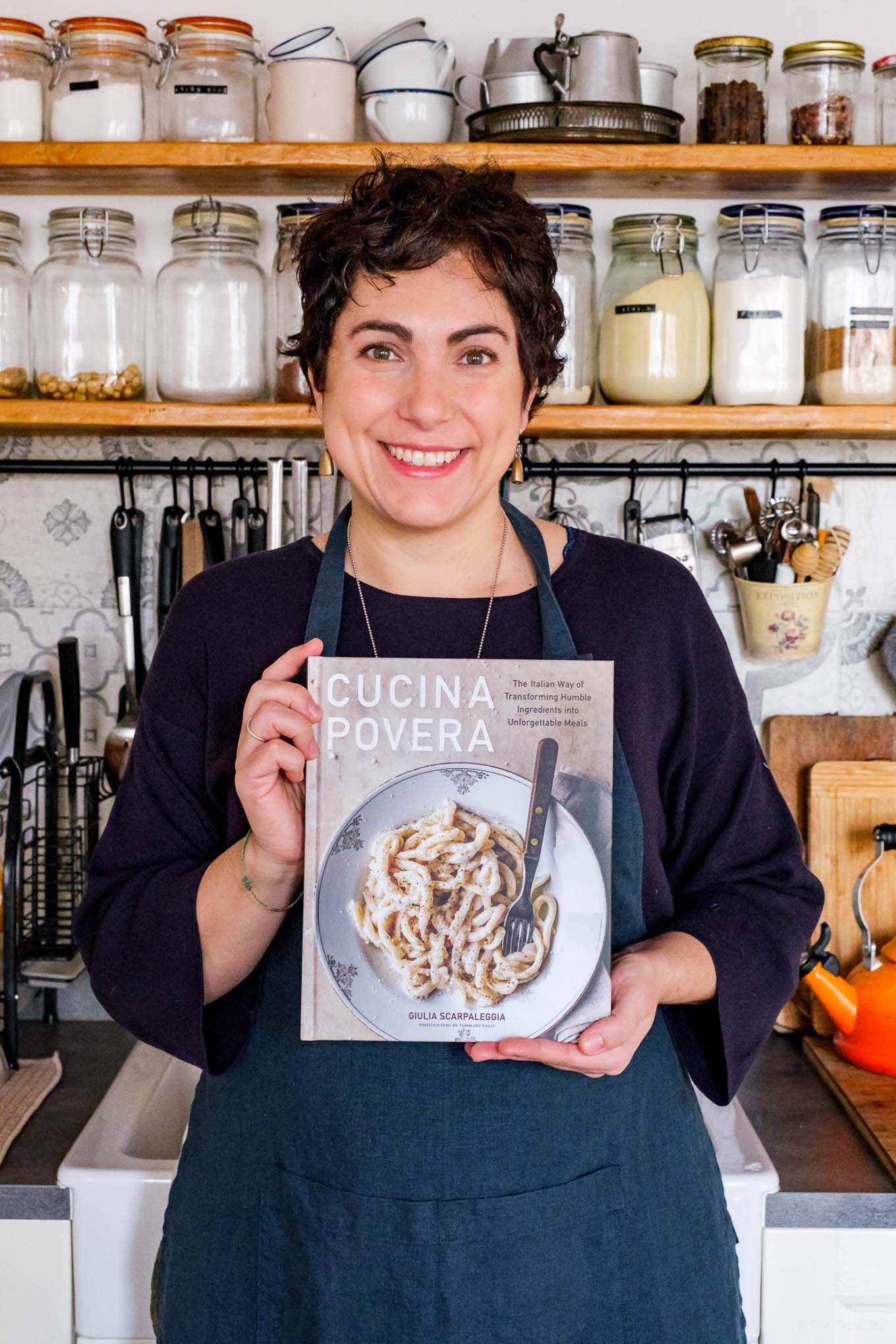
Tell us about you and what you do.
I’m Giulia, a 41-year-old Tuscan-born and -bred food writer, cookbook author, and cooking class teacher.
I started from a deeply rooted passion for simple, traditional Tuscan food which turned into my blog, Juls’ Kitchen, in 2009. I teach Tuscan cooking classes and maintain a blog, a newsletter, and a podcast called Cooking with an Italian Accent.
I am a proud home cook: I learned to cook from my grandmother and my mother, and, as a cookbook lover, from cookbooks. I am passionate about seasonal, nourishing, uncomplicated food.
I work with my husband Tommaso Galli, who’s the head taster, photographer, video maker, and podcast producer. Juls’ Kitchen is our family project.
We live in our family house in the Tuscan countryside with our daughter Livia and our two rescue dogs, Noa and Teo.
You’ve written several cookbooks already. How did the Cucina Povera cookbook come about?
I was contacted by Artisan Books during the first Italian lockdown in 2020 with the proposal of writing a cookbook about the Italian Cucina Povera. I got immediately excited as cucina povera is the way we’ve been cooking in my family since I can remember, the same approach to food I have when I teach cooking classes, and the way I still cook on a daily basis.
We wanted it to be a comprehensive book on the Italian Cucina Povera tradition so that leafing through it you could have a sense of the principles of this kind of cuisine and of the complex history and geography of our country. Of the way we have traditionally eaten in the past, of the way we eat at home now.
There had to be weeknight meal ideas, something you could quickly stir together with pantry ingredients, seasonal recipes, where the freshness of the produce could shine through simple preparations, and celebratory dishes, designed to feed small crowds and exalt the Italian joy of conviviality. I wanted to include recipes with an unmistakable Mediterranean approach and recipes with a distinctive mountain feel, recipes that clearly stemmed from the country peasant tradition, and recipes born in the city streets.
You can order Cucina Povera here along with Gulia’s other cookbooks here.
What do you think the biggest takeaway is for people who read your new book?
The respect of ingredients: when possible, shop local and seasonal, and you will be able to purchase food at a better value, of higher quality, and taste, and definitely more sustainable.
What’s one of your favorite recipes in the book and why?
I really love pappa al pomodoro, it’s my comfort food, and a delicious Tuscan soup made just with stale bread, tomatoes, and good extra virgin olive oil.
You talk about Italian street food in your book. What street food do you crave?
Ah! Difficult to choose: usually when something is hot, fried and salty it’s irresistible for me! But I’d say cinque e cinque from Livorno, a soft focaccia stuffed with a slice of torta – the Tuscan chickpea cake – and grilled eggplants with parsley and garlic, plenty of garlic.
Tell us what one of your cooking classes looks like.
When you opt for a market cooking class, we meet in front of a very small market, just a couple of stalls, but there’s everything you might want. We start with a small breakfast at the local café – espresso, cappuccino, and a selection of pastries: this gives us time to know each other and decide the menu of the day, based on preferences and seasonality. After breakfast, we head to the market where we buy fruit and vegetables and cheese, and after that to the butcher, where we have also a tasting of their artisanal products.
After the market visit, we drive back home to my kitchen studio in the countryside where we have a 3 hour-hands-on cooking class, followed by a delicious meal: appetizers, first course – usually fresh homemade pasta with a seasonal dressing, main course and a couple of side dishes, and dessert. The meal is always vegetable-forward, vibrant and seasonal.
What has been one of your most memorable meals in Italy?
It was at Pietro Zito’s Antichi Sapori, near Castel del Monte, in Puglia. I’ve always loved his farm-to-table approach before the farm-to-table was a trend. He cooks the ingredients that come from his beautiful vegetable garden, those that he forages from Le Murge, and what is typical and local to his area. The meal begins with plenty of small tastings, so simple yet surprising, where the freshness of vegetables and local cheese is paramount. Fresh homemade pasta follows, and then you have a selection of grilled meat, always accompanied by seasonal vegetables. When you think you cannot eat anything else, there come the desserts. yes, desserts, one better than the other, but I need to mention at least their fresh ricotta cassatina, light and sweet as a cloud – and their almond cookies, really addictive.
What do you wish people knew before visiting Tuscany?
Tuscany is not just a postcard: our aim with our food experiences is to show you the real side of Tuscany. We have breakfast at the local café, shop at the market, and cook in our studio, located in our family farmhouse.
What are you making in your kitchen this week?
I bought plenty of vegetables, as usual. When I plan the week I first pick what is in season, vegetable-wise, then decide what to cook with that.
So at the moment, it will be pizza di scarola, a southern pie with escarole, agretti – monk’s beard – with spaghetti, an octopus and potato salad, and pappa al pomodoro, for sure!
What’s the best way to get in touch?
You can subscribe to our newsletter, www.lettersfromtuscany.com, and you’ll receive weekly updates, recipes, and stories, plus monthly cook-alongs and live talks, and a serialized Tuscan cookbook over the course of a year, for the paid subscribers.